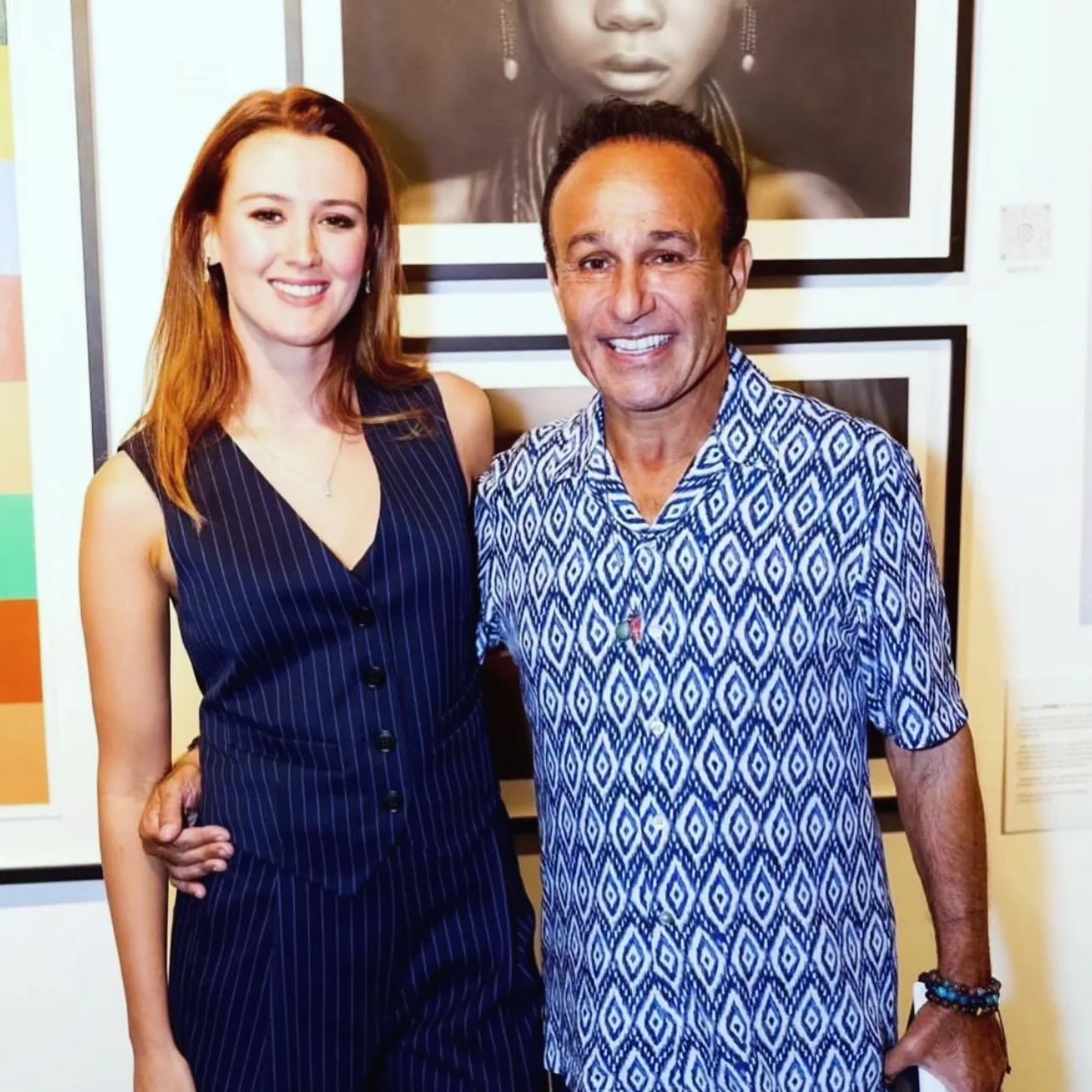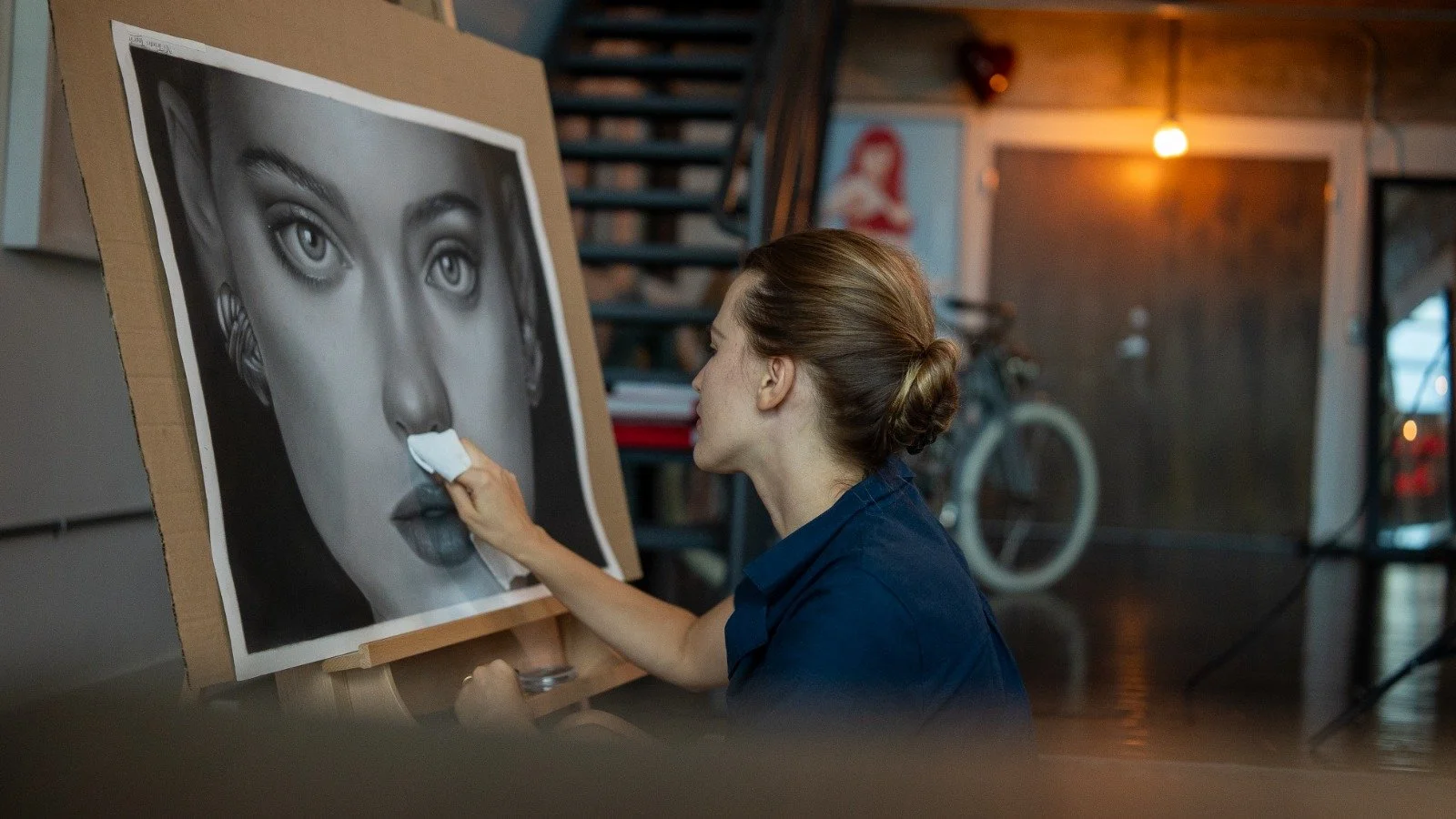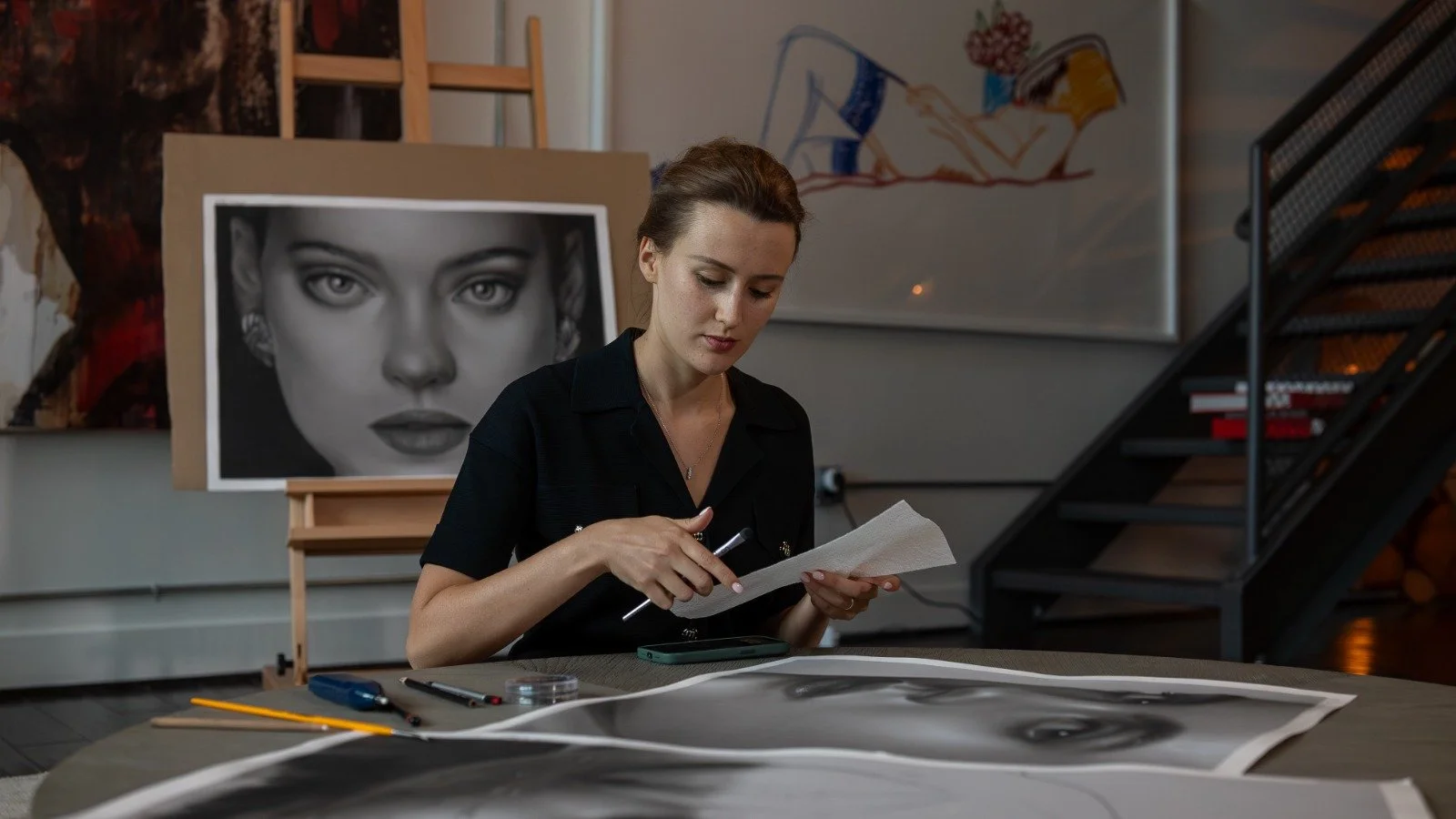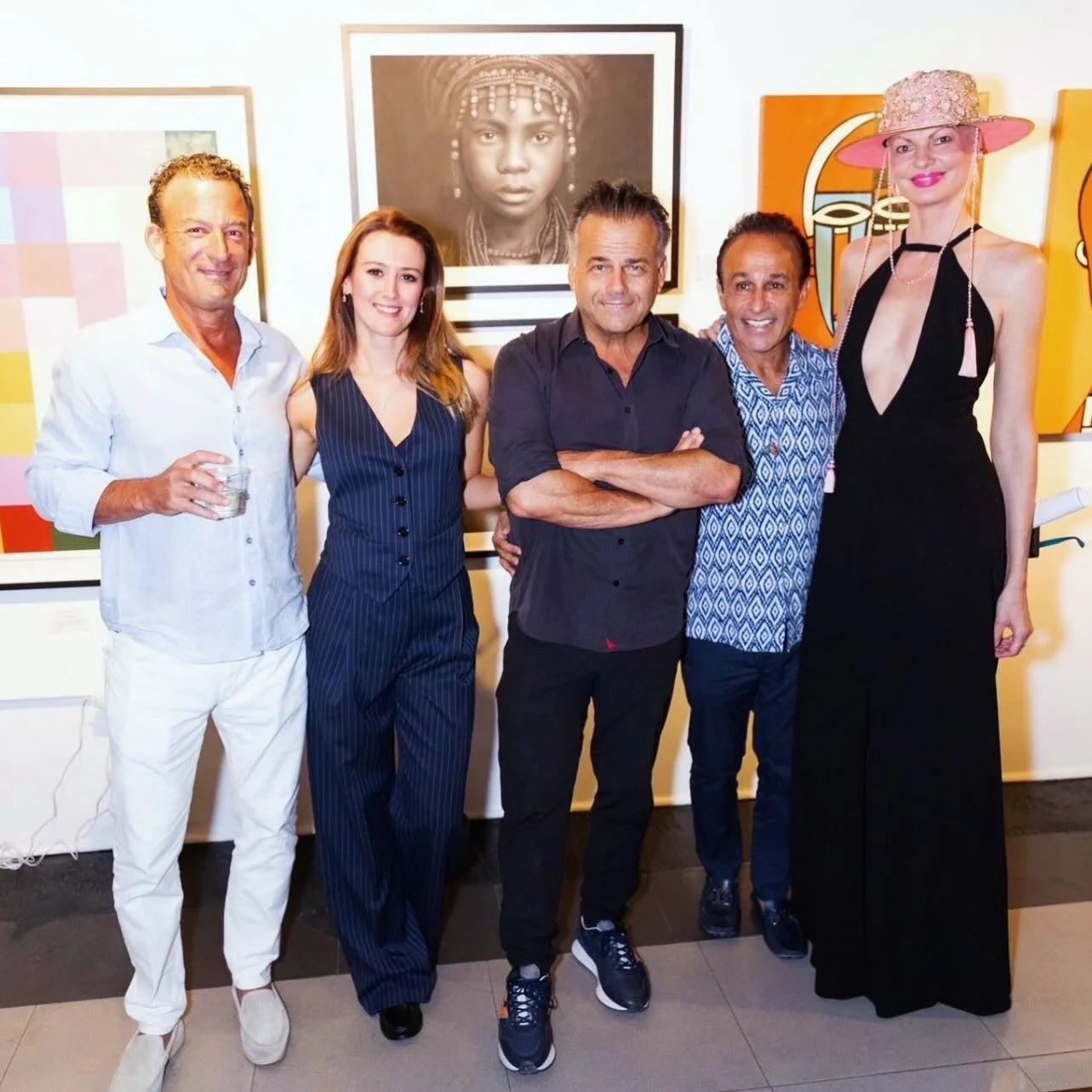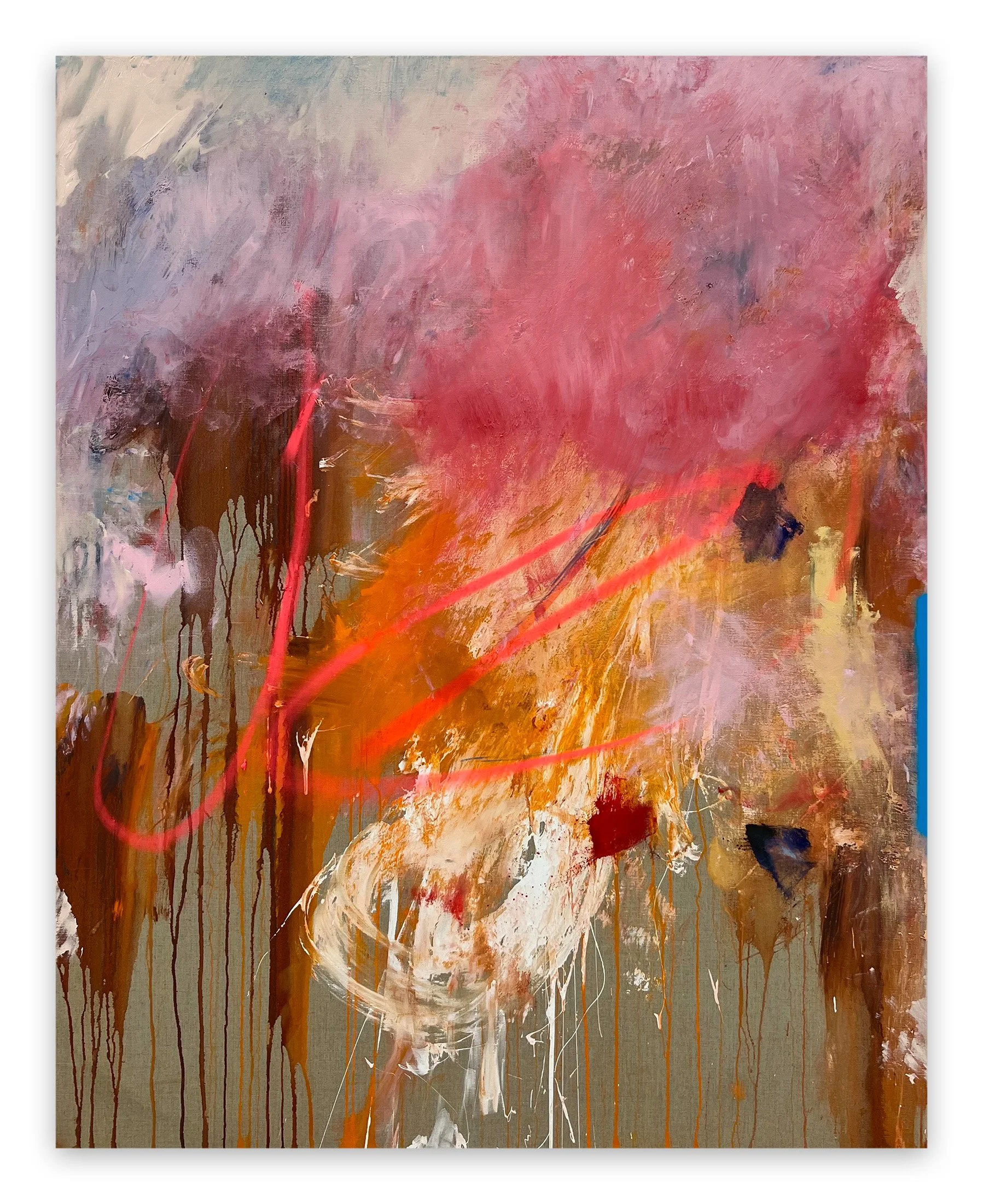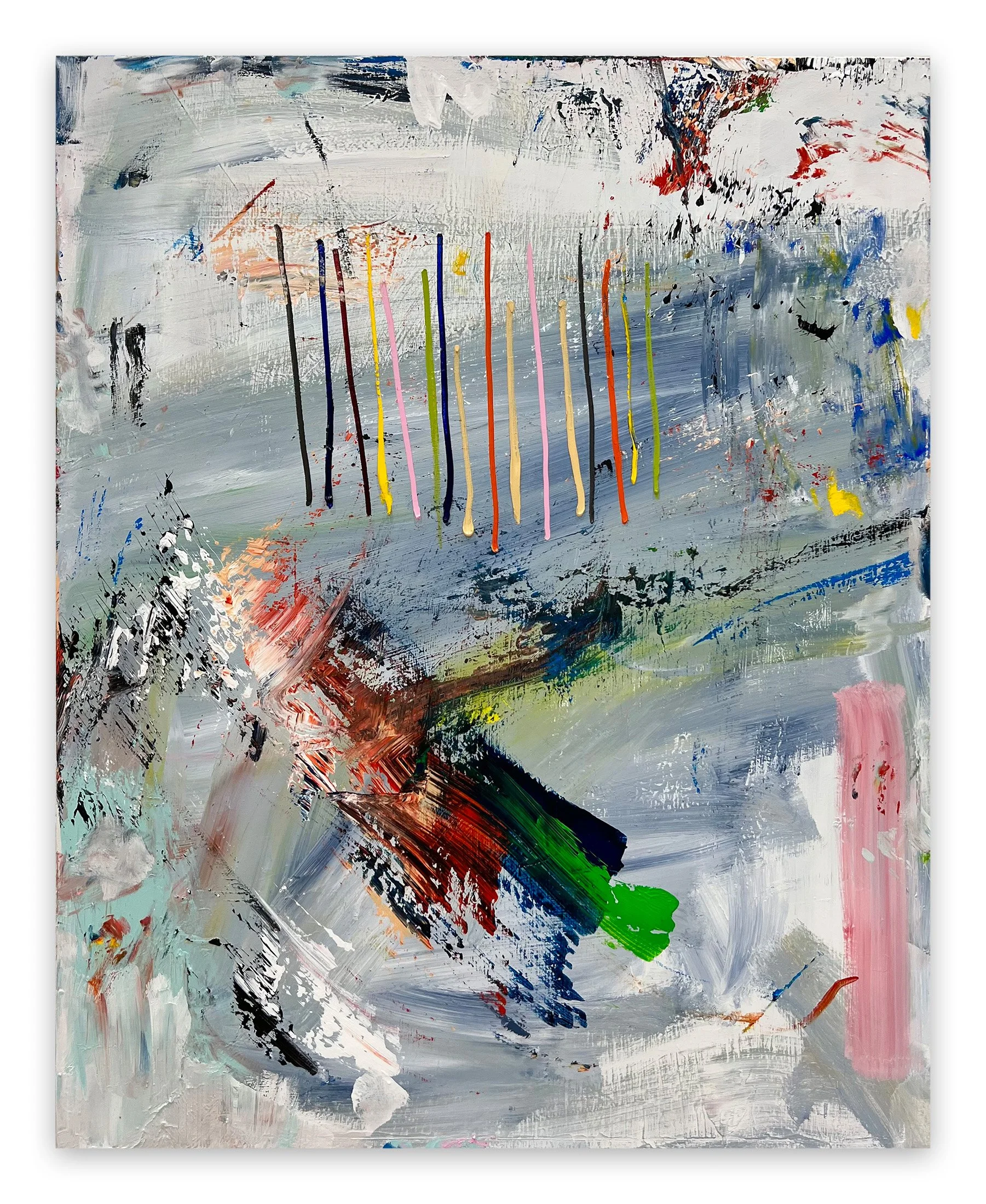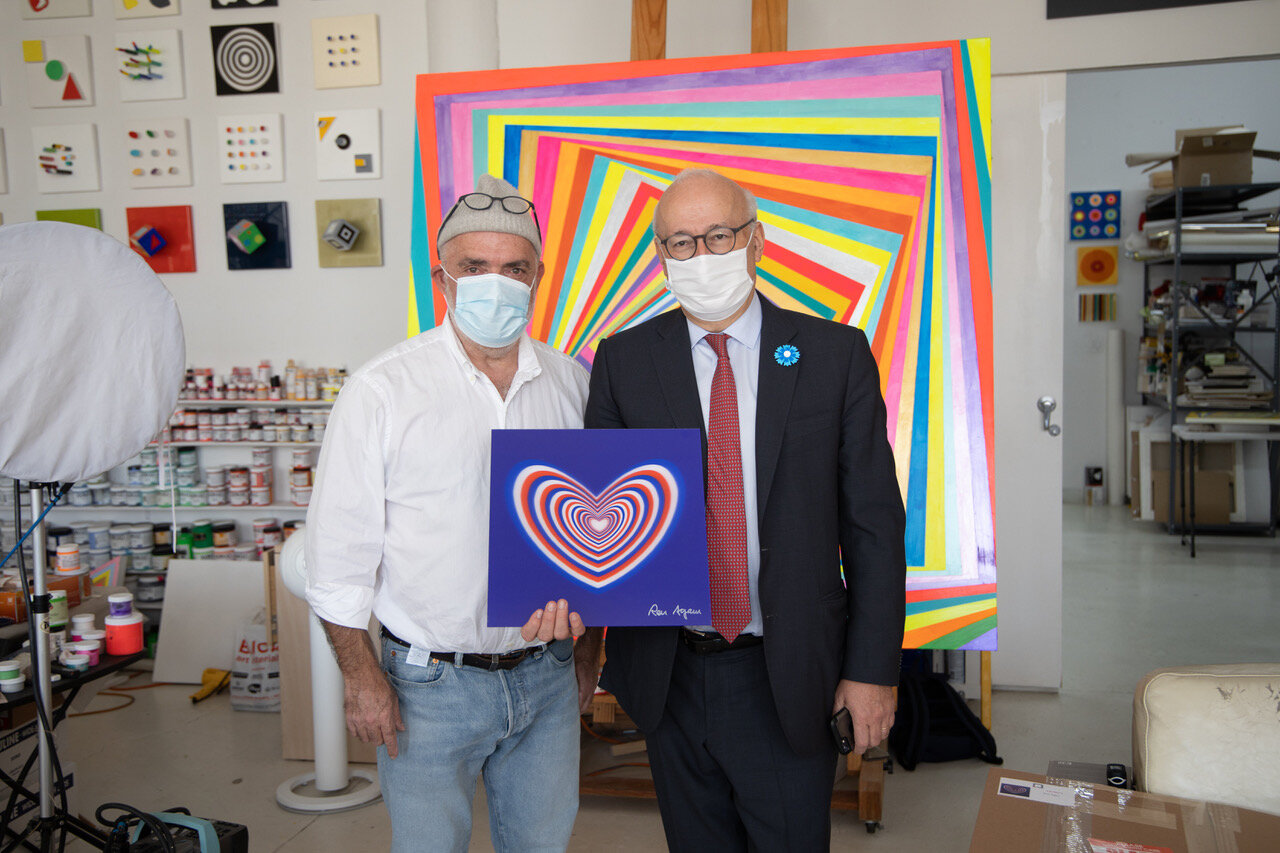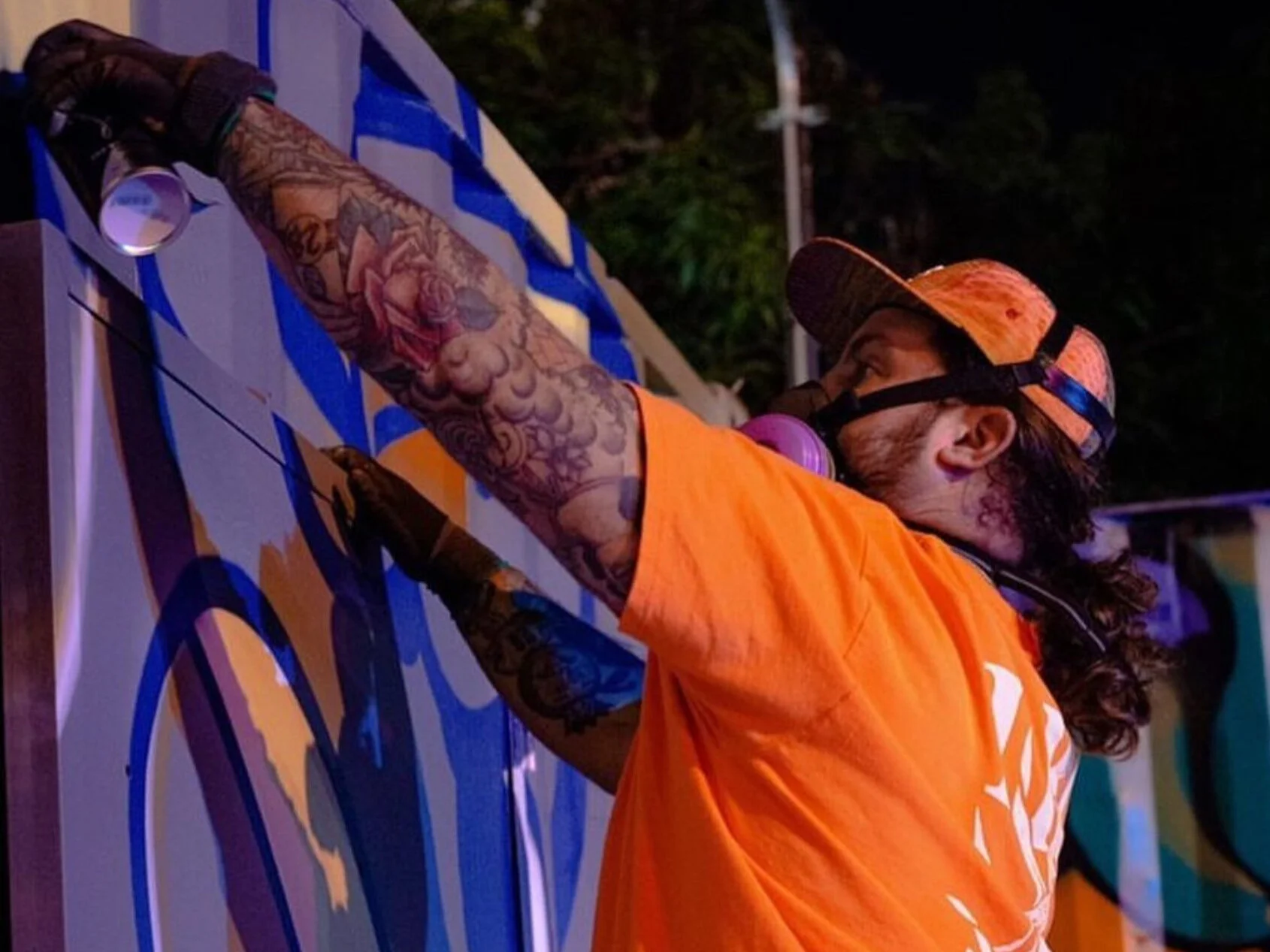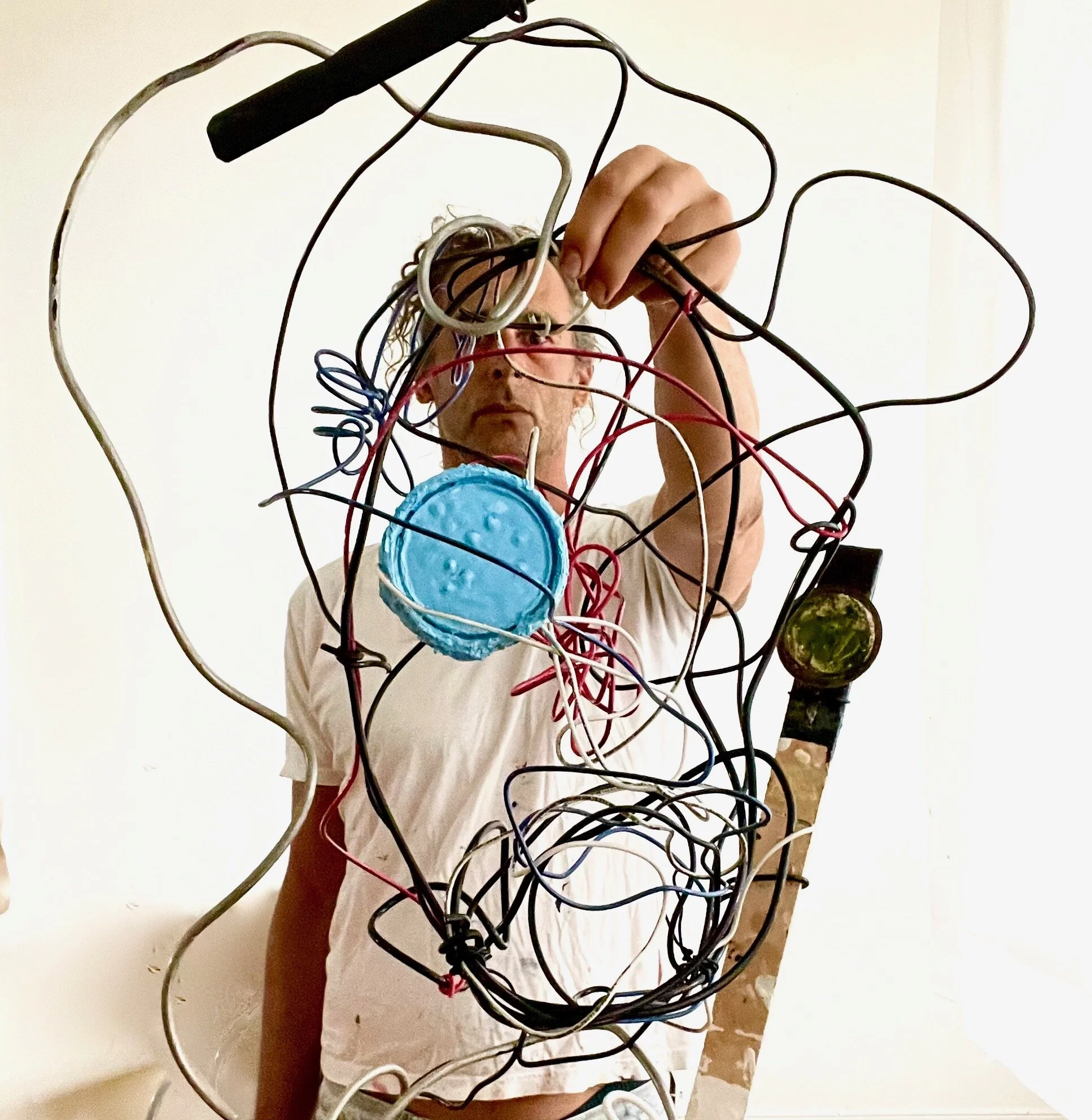Yana Volf: Where Meticulous Precision and Patience Define Artistry
Yana Volf and her world of precision and patience
From Uzbekistan, she unveils mesmerizing optical illusions and precision in her charcoal portraits, capturing near-photographic perfection. Explore her meticulous compositions where patience meets artistic passion.
INTERVIEW WITH YANA VOLF
The anniversary group show at Les Couleurs Art Gallery was a celebration of Miami's vibrant artistic community, curated with meticulous care by gallery owner Aura Copeland and architect Robin Anezin. Located in the heart of Downtown Miami on East Flagler Street, the gallery has swiftly become a cultural focal point, nurturing emerging visual artists from diverse backgrounds over its inaugural year.
The evening was a testament to this cultural impact, drawing in 400 attendees eager to explore the works of 20 local artists whose creations adorned the gallery walls. Among them, the spotlight shone brightly on Yana Volf, an artist hailing from Uzbekistan, whose optical art geometric pieces captivated with their intricate designs that spoke of hours of meticulous craftsmanship and patience. Her charcoal drawings, equally compelling in their depth and detail, drew admiration and were swiftly acquired by Miami's renowned developer, Moishe Mana.
The event buzzed with energy as guests mingled, discussing the nuances of each piece and the broader themes of the exhibition. Prominent architect Kobi Karp added to the evening's prestige, engaging in conversations that bridged the worlds of art and architecture. Sparkling with conversation and punctuated by bursts of applause, the night encapsulated a year's worth of dedication and creativity, transforming Les Couleurs Art Gallery into a beacon of artistic expression in Miami's cultural landscape.
Artist YANA VOLF in her studio
from artist’s archives
LES COULEURS: What’s your background?
YANA VOLF: I was born in Uzbekistan, grew up in Turkey, and am now based in Miami.
LC: What’s your earliest memory of picking up a paintbrush?
YV: I’ve always loved drawing for as long as I can remember, but I picked up a paintbrush at the age of 10 when I began taking oil painting classes in Turkey.
LC: What themes do you pursue, what does your work aim to say?
YV: For the past three years, I have been very focused on my art. The first two years were concentrated on improving my skills, while the last year has seen me experimenting with new elements like incorporating colors and creating variety of shapes. Currently, I am really enjoying the harmonious and positive vibe my art exudes. It has also been very therapeutic for me. As of now, I don’t have a specific theme for my art; I am still exploring and on my journey to find my unique style.
Artist YANA VOLF in her studio
LC: If you could live with just one work of art, what would it be?
YV: If I could live with one work of art, it would be Van Gogh's 'Starry Night.' Its dynamic, dreamy essence is something I could explore and appreciate every day.
LC: What is your dream project?
YV: My dream project involves merging realism and optical art on large scale canvas or paper.
LC: Who are your biggest influences?
YV: My greatest influences include Chuck Close and Silvie Mehdal, along with Zaha Hadid, who is renowned for her fluid and futuristic architectural designs.
LC: Can you tell us about the process of making your work?
YV: In creating my artwork, I begin by conducting some research and combining several different images to form a unique composition. Once I have a clear concept, I sketch out the initial design. If I'm working with charcoal, I first fix the sketch to ensure it doesn't get lost during the drawing process. I then use three different charcoal pencils to begin shading the sketch. To achieve smooth transitions and soft textures, I use kitchen roller paper to smudge and blend the charcoal. For my optical art, I extensively use tape to achieve precise and perfect shapes, ensuring clean lines and accurate forms in the composition.
LC: Have you ever had a moment when you questioned your career entirely?
YV: Before settling on art as my career, I experimented with various jobs. These experiences confirmed my passion and commitment to art, leaving me with no doubt that it is the right path for me.
Alan Omsky, Yana Volf, Kobi Karp, Moishe Mana and Aura Copeland at Les Couleurs Art Gallery - Anniversary Show.
LC: If you could steal one painting, (from any gallery or museum) and you knew you would never be caught,- what would it be?
YV: If I could choose one painting to "steal," it would likely be one of Lionel Smit's works. He paints women's portraits using oils but employs a very unique style, layering colors thickly one atop the other to create a striking, textured effect.
LC: What role does the artist have in society?
YV: Artist plays a vital role in society by reflecting on cultural values, challenging norms, and inspiring creativity and emotional expression.
Tommaso Fattovich and his Abstract World
Fattovich’s skillful use of powerful brush strokes and bright colors beautifully exposes artist’s admiration for extreme juxtapositions. His creative energy and expressive abstractions are undoubtedly generated from within.
Fattovich’s skillful use of powerful brush strokes and bright colors beautifully exposes artist’s admiration for extreme juxtapositions. His creative energy and expressive abstractions are undoubtedly generated from within.
INTERVIEW WITH TOMMASO FATTOVICH
Artist TOMMASO FATTOVICH
from artist’s archives
Tommaso Fattovich describes his early life in Milan, Italy, as his first significant education in the fine arts. His family moved to the US when Fattovich was in his teens. He continues to draw inspiration from both places, as well as the deep contrasts between them. A self-taught painter, and a self-defined abstract punk, he has always valued self determinism above all else, and spends his studio time alienating himself from the pull of the outside world in order to create from the most authentic inner source. Fattovich’s powerful compositions, eloquent and raw in their palette and gesture, draw the viewer into sense the often overlooked, and at times overwhelming, energy all around them in the world. The vast art landscape created by a burgeoning Wynwood Art District in Miami became the backdrop to Fattovich’s first fine art exhibitions beginning in 2010. His work has since been included inexhibitions in Miami, San Francisco, Palm Springs, Los Angeles, Las Vegas, Boca Raton, East Hampton,as well as his first solo show in New York at CJ One Gallery in 2021. The artist currently lives and works in Boca Raton, FL.
LES COULEURS: What is your dream project?
TOMMASO FATTOVICH: My dream project would be to organize a group show with my favorite living artists: Sebastian Helling, Taylor Anton White, Jorge Galindo, William Quigley, Angela China, Gregory Coates, Harif Guzman, Jenny Brosinski, Richie Culver, Marcus Antonius Jansen and Bel Fullana. Each one of these artists really brings out a unique perspective and energy which invite reflection and conversation.
Artwork by Tommaso Fattovich
From artist’s archives
LC: What’s your earliest memory of picking up a paintbrush?
TF: Coloring outside the lines – my earliest memory in elementary school when the art teacher specifically told us to color within the margins …what a rebel I was lol.
Artwork by Tommaso Fattovich
From artist’s archives
LC: What exhibitions are you working on or have you participated in?
TF: I’ve recently concluded my second solo show at the Bailey Contemporary Arts Center called “ABSTRACT PUNK”, in Pompano Beach, curated by wonderful Juliana Forero, Ph.D., founder of Nomad Art Projects – check out www.nomadartprojects.com for more exhibits. The vast art landscape created by a burgeoning Wynwood Art District in Miami became the backdrop to my first fine art exhibitions beginning in 2010. My work has since been included in exhibitions in Miami, San Francisco, Palm Springs, Los Angeles, Las Vegas, Boca Raton, East Hampton, as well as my first solo show in New York at CJ One Gallery in 2021. I currently live and work in Boca Raton, FL.
Artwork by Tommaso Fattovich
from artist’s archives
LC: What’s your background?
TF: I was born in Milano, Italy - growing up in Europe was my first significant education in the fine arts. My family moved to the US when I was 15 years old. I graduated with a Bachelor's in Communication and a Master of Science in International Business from Florida Atlantic University.
LC: Name three artists you’d like to be compared to.
TF: I could only wish to be compared to the 3 greatest in my opinion: Cy Twombly, Julian Schnabel and Franz Kline.
LC: If you could work within a past art movement, which would it be?
TF: I would have loved to work as part of the French New Wave - a French art film movement that emerged in the late 1950’s. The movement was characterized by its rejection of traditional film-making conventions in favor of experimentation and a spirit of iconoclasm. Yes, this is in regard to film, which is still one of my passions. I think I apply the spirit of this movement to my approach with painting – as a self-taught painter, and a self-defined abstract punk, I’ve always valued self determinism above all else, and spend my studio time alienating myself from the pull of the outside world in order to create from the most authentic inner source.
LC: What role does the artist have in society?
TF: Communicating, sharing and building bridges.
LC: Which artist of the past would you most like to meet?
TF: I think it would have been a unique experience to meet Salvador Dalí and have a surreal talk about films and food.
LC: How would you define beauty in 140 characters or less?
Beauty is an evolving concept, mirroring the time we live in – to me, when I paint and create something ugly and can still find the comfort and beauty of it – that’s beauty.
LC: What art do you most identify with?
TF: Abstract or anything out of left field that makes me stop and think – I gravitate towards the absurd, the clever, the chaotic and the minimalist – yes, one extreme to the other lol.
What is your favorite art gallery in Miami and why? My favorite art gallery in Miami is Blink Group Gallery, owned and run by the amazing Elizabeth Reyes (www.blinkgroup.net). She has been a strong voice and leader in the art world especially the Miami scene. She provides collectors with stunning works from artists she selects with passion and intelligence.
LC: Which writer or poet do you return to the most?
TF: Edgar Allan Poe, Oscar Wilde and Friedrich Nietzsche.
LC: Was there a pivotal moment when you decided to follow your path as an artist?
TF: I remember a friend of mine showing me William Quigley’s artwork. It was eye opening – to this day he has been such a great inspiration and mentor. He has given me direction, advice on which materials to use while painting, how to properly market myself and has included me in the artist collective he runs with AB Gallery in East Hampton (www.abnygallery.com). I love how William unites people, artists and collectors and gets them excited about creativity and critical thinking – he’s an ocean of knowledge. I would like to be like that too one day. That’s what made me decide to follow the path as an artist.
LC: Professionally, what’s your goal?
TF: I think I am still learning and improving my skills – I feel like being an artist is a lifelong journey of discovery and experimentation. There really is no “finish line” in this field. Being an artist is about the final product – putting out quality timeless authentic works. I have built strong relationships with my galleries and collectors who are supporting me and inspiring me every day to keep moving forward while pushing the boundaries of what I can do next.
Ron Agam’s Relentless Attempt to Repair the Imperfect World
Artist is using an enlarged flower as a symbol of purity in hopes that its fragility and perfection will encourage us to treasure and care for our planet.
Artist is using an enlarged flower as a symbol of purity in hopes that its fragility and perfection will encourage us to treasure and care for our planet.
INTERVIEW WITH RON AGAM
Artist RON AGAM
from artist’s archives
Born in 1958, and raised between Paris and Rehovot, Israel, painter Ron Agam only took up the paintbrush later in life, following a long and successful career as a fine art photographer. Yet, the robustness and sheer prolificacy of his output since belies the charge that this newfound passion is anything but a calling. Since first embracing his new medium a few short years ago, Ron Agam’s creative energy has burst forth, embracing a dizzying array of techniques and a brilliant spectrum of forms, in an ever-expanding constellation of individual works. From lenticular, optical experiments to distilled, saturated color-fields, Ron Agam’s work has, canvas by canvas, explored the process of seeing, all the while keeping an eye on the prize of metaphysical meaning.
Artist Ron Agam with French Ambassador Philippe Etienne
From artist's archives
LC: What role does the artist have in the society?
RA: The role of a creative person is to open a window of imagination in others. It’s to take us away from the mundane, to introduce us to the world that’s limitless. Look at a newborn child, he sees before he can understand anything, the child is usually very driven to create. Artists are essential for every society and their duty is to open a new field of thought. Some of the greatest artists are the people that were able to keep their inner child alive.
LES COULEURS: What art do you mostly identify with yourself?
RON AGAM: I grew up in Paris, but my mother loved Italy, so we would go to Florence frequently. She would take us to Galleria degli Uffizi where I would look at the works of the Renaissance masters. There was one piece by Piero della Francesca that I fell in love with, it was the portrait of a young prince. I was so fascinated by its extraordinary expression and colors, that it made a long-lasting impact on me.
Artist Ron Agam in his studio
LC: What role did your dad play in your career as an artist?
RA: My father, Yaacov Agam is a great artist too, truly legendary. He is known for pioneering kinetic art, he is in almost every major museum in the world. Naturally, my environment influenced me a lot, I was really born at a right place and at a right time. As children, we were always drawing by our father’s side, he was very patient and was teaching us. All my life I was surrounded by art. My father’s studio used to belong to Paul Gauguin, there you could feel truly a special atmosphere. I experienced the happiest moments of my life while doing my work, it has always been my refuge.
RON AGAM
from artist’s archives
LC: When did you start painting?
RA: It was unthinkable, almost suicidal for me to start painting, and so I tried to break through. At the age of 52, I went on an adventure, and when I started it, I wasn’t even expecting to sell a single painting. Before that, I did everything you can think of: I owned an art gallery, I did photography, I was dealing art, I created all kinds of businesses.
Inspiration is something godly, it’s something that’s gifted. So all these challenges made my story very unique, that’s by itself something that history will have to judge. Just about a year after I started painting, I fell very sick. When I finally recovered, my doctor advised me to take it easy. Me, having this second chance in life, I wanted to maximize the opportunity, to fully take advantage of it. Today, I would like to use my story to inspire others, to never loose trust in yourself.
RON AGAM
from artist’s archives
LC: What doest your art aim to say?
RA: It should uplift the human spirit. I can show my artwork anywhere in the world and people from various walks of life will connect, it is universal kind of connection.
I like to contemplate the idea of disruption. Once, I portrayed the disruption in a perfect square, then later on, I created several works around this concept. Some works are about the movement, we activate change through a movement. Several Russian suprematists influenced me too, especially Malevich and El Lissitzky.
Before I became I painter, I photographed flowers for 2 years. I used to go to a flower shop and buy flowers. The urgent message of a climate change at a time really resonated with me. I think that flower is the most pure symbol of nature, it’s a godly perfection of geometry.
So I decided to enlarge it, to emphasize its fragility. Injustice is also something I think about a lot. I try to repair the world as much as I can, as I was myself victimized as a child and some antisemitic confrontations were especially hurtful.
Years ago, I did a big exhibition at one of the major galleries in Chelsea, during the 2008 financial crisis. It was beautiful to see that my flower images made even sad people smile. Exhibition was very successful and I was able to communicate my massage that’s at a core of our survival as a species, if we don’t take care of the planet we will soon disappear!
Before the first conference on climate change I gifted Former President of France, Sarkozy one of my flower artworks. It was a symbolic gift from me to him, because flower represents everything we try to preserve. The flower series was what psychologically prepared me for painting. The geometry of a flower is just so perfect. Our subconscious is very important, the two years of photographing flowers really influenced me.
Madonna bought few of my artworks, because she felt it had a connection to Kabbalah. My brother is immersed in Kabbalah, my dad is fascinated with it too.
About three years ago I participated in the show at the Jewish Museum in Amsterdam, which was organized around the idea of Kabbalah. Artworks of some other very prominent artists were exhibited there too: Marc Chagall, Anish Kapoor, Anselm Kiefer, Barnett Newman to name a few. When I got to Amsterdam and saw my artwork placed in the very the center of the museum, it warmed my heart immensely, I knew something major is happening in my career.
RON AGAM
From artist’s archives
The Psychology of Art by Lina Condes
While the artist emerges herself in the creating of sculptures using her knowledge of anatomy, proportion and structure, she still considers her family to be the greatest work of art.
While the artist emerges herself in the creating of sculptures using her knowledge of anatomy, proportion and structure, she still considers her family to be the greatest work of art.
INTERVIEW WITH LINA CONDES
LINA CONDES
From the artist’s archives
LES COULEURS: What is your dream project?
LINA CONDES: All of 2020 I was working on a new project called “Flow.” Thinking about our current reality of instant gratification and the everyday competitive grind. The project is about human psychological states, represented by figures in motion.
I studied sports in detail, to be able to accurately capture the essence and the dynamics of real figures in motion. My goal is to capture the essence of motion even though the figure is static. The shape of the body is determined by its skeleton as the main supporting structure. Knowledge of the relative sizes of the articulating bones and their proportions in relation to each other as well as the entire skeleton is essential, because without this information it's impossible to translate the figure to a 3D program and depict it logically and consistently.
This project is a 3D realization, adapted to the current context of a digital pandemic, a new reality where artist’s creative project is changed or undergoes a ‘temporary modification’ if you want, it is indeed an interesting study in the simulation of artworks. This is what brought us exactly to where we are now and the changes we are facing in the contemporary art world, called NFT ART.
LC: What exhibitions are you working on or have you participated in?
LINA CONDES: “Educate” exhibition at Christie’s, “Extraterrestrial Odyssey” for Venice Biennale, “Happy” at M17 Contemporary Art Center, “Dwellings of Eternity” at Crossing Art. At this moment, my sculpture “The Thinker” is at the Summer Exhibition at the San Diego Museum of Art.
LC: If you could work within a past art movement, which would it be?
LINA CONDES: If I could travel in a time machine and work within a past movement I would definitely choose to live between France and Italy and work with Rodin on modern sculptures!
LC: What art do you most identify with?
LINA CONDES: Sculpture.
LC: Can you tell us about the process of making your work?
LINA CONDES: The concept is the most important part of the process, the allegory behind the image. Then goes the visualization using the 3D programs, and then the rest of creative process in my studio!
LINA CONDES
From the artist’s archives
LC: What themes do you pursue?
LINA CONDES: Social and psychological themes.
LC: If you could live with just one work of art, what would it be?
LINA CONDES: My family as main work of art!
LC: What role does the artist have in society?
LINA CONDES: First of all, to help people view the world from a different or novel perspective, also to express emotions in a visible manner and to make social changes.
LC: Which artist of the past would you most like to meet?
LINA CONDES: Salvador Dali, Michelangelo, Rodin, Constantin Brâncuși
LC: What kind of music are you listening to currently?
LINA CONDES: For me, the best music is meditative with high vibrations. I really like the harp and organ. Among the favorites are: Hans Zimmer, Vangelis and André Rieu.
LINA CONDES
Monologue
LINA CONDES
From the artist’s archives
LINA CONDES
From the artist’s archives
LINA CONDES
From the artist’s archives
The Quintessential Miami Artist, Utterly Everywhere
Growing up in the emerging Miami graffiti scene of the ’80s, Atomik witnessed at a young age what would later become his passion and profession.
Growing up in the emerging Miami graffiti scene of the ’80s, Atomik witnessed at a young age what would later become his passion and profession.
INTERVIEW WITH ATOMIK
Artist ATOMIK
From the artist’s archives
LES COULEURS: When did you start doing art and how did your passion for street art come about?
ATOMIK: I've been making art for as long as I can remember, when I started elementary school art was always interesting and fun to me. My passion for street art came about by doing graffiti for many years.
LC: What is your dream project?
A: My dream project is to paint a 10 story building and to collaborate with Nike on a pair of Cortez's.
LC: Name three artists you’d like to be compared to.
A: 2pac. Notorious B.I.G. Big Punisher.
LC: What art do you most identify with?
A: Spray can art.
LC: Who are your biggest influences? Have you ever had a moment when you questioned your career entirely?
A: My biggest influences are my family and friends. I have never doubted my career.
From the artist’s archives
From the artist’s archives
LC: Why do you love what you do?
A: I love making art because it is fun and challenging.
LC: How does your work comment on current social or political issues?
A: My work doesn't comment on current social or political issues, I like to paint my name and character,- bottom line!
LC: What are you working on now? Exciting future projects?
A: I turn 40 this month and will be traveling to Hawaii with my family. I'm looking forward to having some downtime from my normal day to day life.
LC: Tell us about your TOY? Where and when it can be purchased?
A: UVD Toys are awesome. They did a great job creating a vinyl toy out of my chatacter. Big ups to Travis and the whole team over there. The next drop will be this summer on www.uvdtoys.com
ATOMIK
From the artist’s archives
The Colorful World of Jordan Betten
“I work on paintings, sculptures, and collages simultaneously. I like to have multiple projects around me. I create every day and live in my studio. My work and life are one.” - Jordan Betten
“I work on paintings, sculptures, and collages simultaneously. I like to have multiple projects around me. I create every day and live in my studio. My work and life are one.” - Jordan Betten
INTERVIEW WITH JORDAN BETTEN
Artist JORDAN BETTEN
From the artist’s archives
LES COULEURS: What's your earliest memory of picking up a paintbrush?
JORDAN BETTEN: I grew up drawing and painting. From a young age, I remember painting horses and superheroes at the kitchen table.
LC: Before you moved to Miami, what were you doing in New York?
JB: I lived in New York City for twenty years doing my custom leather brand Lost Art. (lostart.com). Lost Art is an art and design brand creating clothing and accessories with leather, snakeskin, and other natural materials. Every piece is entirely handmade. We dressed many rock stars and celebrities, Lenny Kravitz is my biggest collector.
LC: What artist from the past would you like to meet?
JB: The American Indian cave painters.
LC: Can you tell us about the process of making your work.
JB: I call my style Deconstructed Realism, I like to paint figures and forms but in an abstract way. The figures add a soul to the paintings that are felt even if they are not recognizable. I paint fast and free. I often use both my right and my left hand to paint and draw, as they create different lines and marks. Most of my time is waiting for the layers of paint to dry.
Artist JORDAN BETTEN
From the artist’s archives
LC: What themes do you pursue?
JB: I like the themes of the Wild and Rebel living, the American Indian culture, Hell’s Angels, the free spirit of Rasta and the Old Soul.
LC: What are you working on now?
JB: I work on paintings, sculptures, and collages simultaneously. I like to have multiple projects around me. I create every day and live in my studio. My work and life are one.
LC: What role does the artist have in society?
JB: To provide the material that makes society special. We add the color, the light, and the spirit. Art makes us think and feel.
Artist JORDAN BETTEN
From the artist’s archives
Artist JORDAN BETTEN
From the artist’s archives


